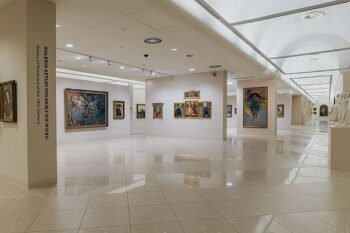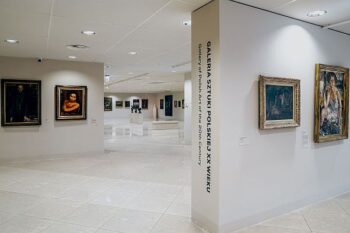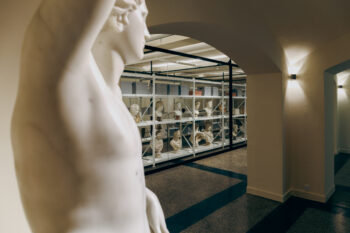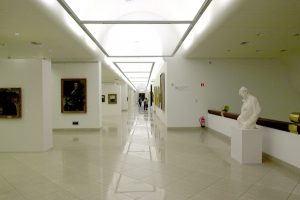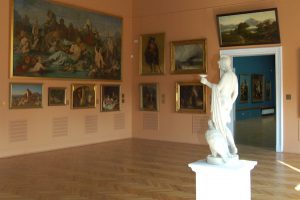The beginnings of the European art collection in the Poznan Museum can be traced back to the opening of the German Provincial Museum (Provinzial–Museum) in 1893, which was transformed into the Kaiser Friedrich–Museum in 1903.
The exhibition then presented modest acquisitions of its own and deposits from the National Gallery in Berlin. However, the most significant enrichment of the collections was the acquisition in 1903 of nearly 200 works from the Atanazy Raczyński Gallery, transferred from Berlin and deposited by the Raczyński family from Obrzycko. This set is still the core of the European Art Gallery. Since 1997 it has been part of the collections of the Raczyński Foundation at the National Museum in Poznań.
Until 1918 the collections of paintings and sculptures were mainly enriched with works of German artists from the 19th and early 20th centuries, but also French – Auguste Rodin and Claude Monet.
After the First World War, the Greater Poland Museum took into custody paintings from the collections of the Mielżyński Museum of the Poznań Society of Friends of Science, mainly from the gift of Count Seweryn Mielżyński (1804-1872). The works of Italian, Dutch and Flemish painters such as Palma il Vecchio, Joos van Cleve, Jan van Goyen and Daniel Seghers had a special status in this collection.
The purchase in 1930 of several dozen valuable paintings from the former Karl von Wesendoncka depository in Berlin was particularly important. These included works by Joos de Momper, Arie de Vois, Floris van Schooten, Herman Saftleven and Hans Makart as well as Arnold Böcklin.
During World War II, the Museum, run by the Germans under the name Kaiser Friedrich-Museum Posen, increased its collections through purchases on the art market of works by old masters (e.g. Hans Dürer, Alessandro Turchi, Caesar van Everdingen)
Since 1942, the most valuable objects have been transported to Germany (mainly to Saxony). Part of them disappeared, including Lorenzo di Credi‘s paintings, Antoine Pesne‘s sketches, Rubens‘ studio sketches and many others. The post–war rewindykacja of collections from Moscow (where they arrived from Germany) allowed the recovery of some of the lost exhibits in 1946 and 1956.
Among them were also dozens of paintings from the former collection of the Czartoryski princes in the castle in Gołuchów, including excellent works by Pablo da San Leocadio, François Quesnel, Bartholomeus van der Helst and the excellent “Fishing on the Rhine near Arnhem“ by Salomon van Ruysdael.
The paintings from Edward Alexander Raczyński‘s Rogalińska Gallery have also returned and are now being displayed again in the palace in Rogalin.
After World War II, the collections of European art at the National Museum were greatly enlarged with the addition of many valuable works by such artists as Ugolino da Siena, Giovanni Bellini, Jusepe de Ribera, Simon Luttichuys, Franz von Stuck, Pierre Bonnard, Aristide Maillol, and Emilio Vedova.
The Poznań collection of European art is one of the most important and largest in Poland.
The collection has examples of creativity from all circles and eras, from the 14th to the 20th century.
In two cases, the Poznan collections are unmatched.
The strongest element of the Gallery is the collection of Spanish Baroque painting, the only one of its rank and size in Polish museums – with works of the highest artistic class by Francisco de Zurbarán, Jusepe de Ribera, Juana Carreño de Miranda or the circle of Diego Velázquez.
The other distinguishing feature of the Poznań Museum is the largest and most valuable collection of German painting from the 19th and early 20th centuries in Polish museology, starting with Romanticism, with an unparalleled collection of paintings by the Nazarenes (Peter Cornelius, Friedrich Overbeck, Wilhelm von Schadow), artists of the Berlin, Düsseldorf and Munich schools (Franz Lenbach or Wilhelm von Kaulbach with his gigantic “Battle of the Huns“), German Impressionists (Max Liebermann, Lovis Corinth, Fritz Uhde), Symbolists (Arnold Böcklin) or Secessionists (Franz von Stuck).
Particular value is also the collection of works of early and mature Italian Renaissance with pictures of such masters as Lorenzo Monaco, Ambrogio Bergognone, Giovanni Bellini, Giacomo Francia, Agnolo Bronzino, Jacopo Bassano or Sofonisba Anguissola with her famous “Chess Game” from 1555. Mannerism and Italian Baroque painting is represented by paintings by Bernardo Strozzi, Domenichino, Massimo Stanzione or Salvator Rosa.
Also very well represented is the painting of the Northern Schools, from the 16th century Dutch (Quentin Massys, Joos van Cleve and the Master of the Female Half–lengths) to the Dutch (Jan van Goyen, Salomon van Ruisdael, Pieter Nason, Adrian van Ostade) and Flemish 17th century (Frans Snyders, Daniel Seghers). There are also examples of German and French 16th century painting (Lucas Cranach, François Clouet, François Quesnel), French 17th and 18th century painting (Hyacinthe Rigaud, Louis Lagrenee, Antoine Pesne).
The National Museum in Poznań collection is also distinguished by a specific accent, as here we can view “The Beach at Pourville“, the only painting of the great French Impressionist master, Claude Monet, in Polish museology.
Currently, the collection of paintings and sculptures of the European Art Gallery consists of over 2000 objects. The most magnificent of them (nearly 300) are presented in the Gallery on the first floor of the Main Museum Building. Others can be seen in the residential departments of the National Museum in Rogalin, Śmiełów and Gołuchów.


